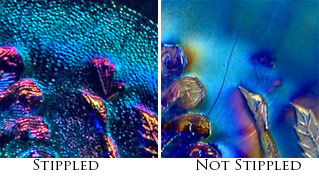Dugan And Diamond Cherries
By Dr. Larry Keig
This is a revised, amended, and updated version of an article that appeared in the March 2017 issue of The Carnival Pump.
From 1909 through the mid-twenties, the glassmaking factory at Indiana, Pennsylvania, made and marketed no fewer than five carnival patterns with Cherries as primary patterns. Cherries/Jeweled Heart and Cherries/Daisy and Plume were produced exclusively during the Dugan years (1909-1913). Paneled Cherries and Wreathed Cherry were manufactured by both Dugan and Diamond. Weeping Cherries was a Diamond-only creation, perhaps introduced in the early 1920s.
The Cherries patterns on bowls and plates are contradistinctive yet, for three of them, the differences are slight. It is unnecessary, however, to know precisely how they differ in order to tell one from the other. Cherries/Jeweled Heart has a circular collar base, Paneled Cherries is ball-footed, Cherries/Daisy and Plume is splay-legged, the bowl and collar base of Wreathed Cherry are ovular in shape, and Weeping Cherries is dome-footed. Their back patterns are also entirely different.
Cherries are also found on other patterns and shapes, notably the Many Fruits punch bowl and base, but are not the only fruit to be found. A Cherries vase that some believe to be Dugan or Diamond is also available. Neither of these patterns is discussed here.
Cherries/Jeweled Heart
Cherries/Jeweled Heart is an appealing pattern with clusters of the fruit: two clusters with three cherries, the others with two. It also includes realistic-looking stems and veined and stippled leaves. Two large leaves reach the outer edge of the bowl, the remainder not that far. On large bowls, the open area in the center is slightly larger than a silver dollar. On the small, the open area is about the size of a 25-cent piece.
Large bowls have a base diameter of four inches and a 36-point star pressed into the underside of the base. Small bowls have a two and one-half inch base diameter and usually an unpatterned underside.
The ornately cast Jeweled Heart back is also found on the reverse of Dugan’s Farmyard, Petal and Fan, Smooth Rays, and once in a while collar-base Ski Star. Its key features are: (a) highly raised outlines of eight hearts, (b) “jewels” that dangle like glittering pendants from the points at which the ventricles converge and rise like tied down, helium inflated balloons from the tucks at the tip of the hearts, and (c) tiny beads which follow the interior contour of the hearts and jewels. The background within the hearts is stippled. Jeweled Heart is also used as a primary pattern on marigold water sets.
Six- and eight-ruffled large and small bowls are seen more often than other shapes. Large ruffled bowls range from nine and one-half to nearly eleven inches in top diameter, the small from six to just under seven inches. Large bowls are also available in ice cream and proof shapes. The small are found with a tightly- crimped edge as well as the ruffled, ice creams, and proofs. The outer edge of all are serrated. The serrations are prominent on the large bowls, less distinct or even obscure on the small.
Of all large bowl configurations, the eight-ruffled is the most visually striking, especially when the ruffles are highly elevated. The eight-ruffled shown, besides being stunningly beautiful, provides a good sense of ruffles which have been pulled up high.
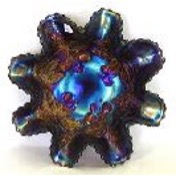
This purple example sold on a Seeck online auction in July 2020. In Dugan’s Cherries, by far the most consequential find in recent years is an eight-ruffled bowl in a standard green. Its top diameter is nine and one-half inches, and it is three inches tall.
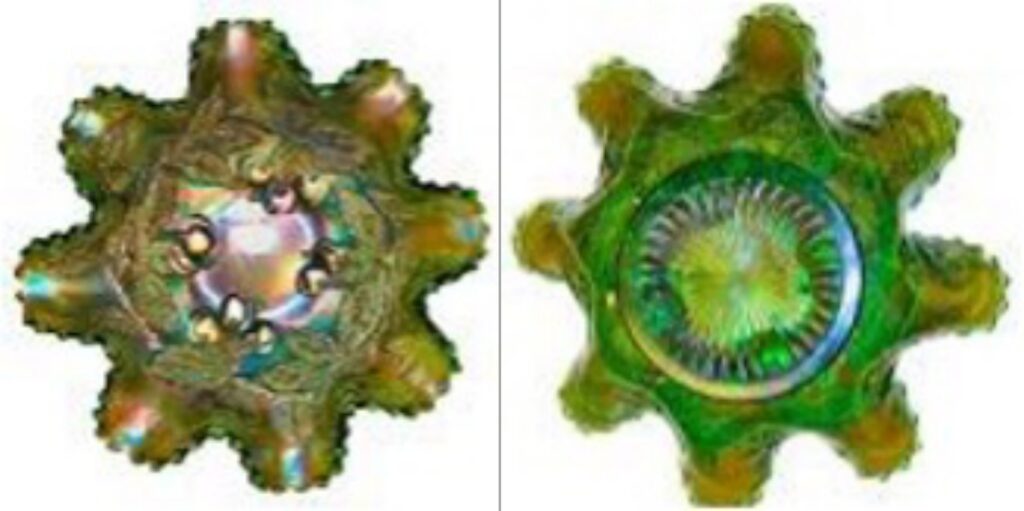
Galen and Kathi Johnson got wind of the estate auction in Pennsylvania on which it was to sell on their way to Florida for the 2019 Tampa Bay convention. But given that it had been accurately listed as a green Dugan Cherries, there was great interest in it at the auction house as well as from one phone bidder who, at the close, was the runner-up. But got it they did, if not at a bargain price. As it turned out, anything but.
“The locals (and non-carnival glass collectors)” were, according to Kathi, “ amazed at the price of that piece. The son of the owners . . was blown away . . . His parents had collected and belonged to a few clubs. He didn’t know where they found it, just said it was probably locally, and they did display it on a shelf for many years. But he had no idea that they had one piece that would bring that much money. He wanted to know what made it worth that to us, so we explained that Dugan made a very limited amount of pieces in green and because of the condition and color (and its rarity as green Dugan), it took the value way up. And we got to explain that many times to the locals in the crowd.”
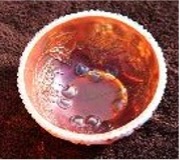
The small non-ruffled ice cream shapes (ICS), only slightly formed post production, and proofs, not configured at all after removal from the mold, surface infrequently. While the distinctions between the two are to some extent fluid, in the small bowls the two shapes can be distinguished from one another by applying two “rules,” both of which must be met: a “two-incher” for height and a “five-incher” for top diameter. To qualify as a small proof or “deep sauce,” a small bowl must be at least two inches tall and less than five inches in diameter. A small bowl that is less than two inches tall and five or more inches in diameter is probably an ICS. The uppermost portion of the sides and serrations of the small proofs run practically perpendicular to the surface on which they rest. The sides of ice creams are more flared than the proofs.
Large bowls are comparably classified: proofs (the deep rounds) are eight or so inches in top diameter and nearly three inches tall. Non-ruffled bowls with more expansive top diameters of eight and one-half to nine inches are likely ice creams. The angle (from base to top edge) of large proofs is considerably greater than the nearly right-angled small bowls.
Large Cherries/J.H. proofs and ice creams have sometimes collectively been described as mid-size even as they were produced from the same mold as all other large bowls.
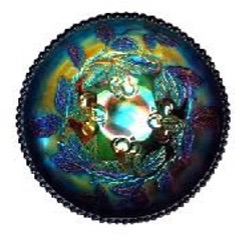
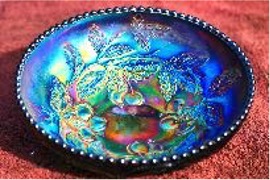
Two impressive large amethyst/purple proofs are illustrated. One, owned at the time by Christina Katsikas, who bought it from Gary Heavin who had found it on eBay, was sold at the HOACGA/Seeck auction in 2017 to Gary Lickver. The other, with a wide swath of bright blue iridescence bordering the clusters of hanging cherries, sold on the Rogue/ ICGA/Seeck virtual (COVID-19 pandemic) convention auction in July 2020.* Its base color is a translucent fuchsia or magenta, not quite red enough to qualify as the more opaque fiery amethyst. No further record of the provenance of either bowl is available.
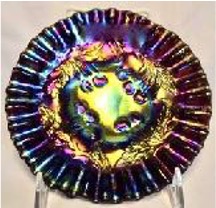
The tightly-crimped sauces are similar in dimensions to ice cream shape bowls. Small plates are also tightly-crimped but shallower than bowls. It should be noted that in this shape a bowl to one collector might be called a plate by another. The tightly crimped pieces are easier to come by than either the ICS or the proof. The purple example shown, with beautiful iridescence, sold at a Wroda auction in 2019.
All shapes are available in peach opal and purple/ amethyst. As already described, a single large eight- ruffled bowl in green has also been confirmed. Marigold and white are said to exist, but there are no records of either having sold.
Paneled Cherries
The interior of the majority of Paneled Cherries bowls is similar to Cherries/Jeweled Heart but less expansive. The inner surface is made up of four clusters of fruit (two with three cherries, the others with two) along with stems and leaves. Two large leaves extend to within about three-fourth of an inch from the outer edge, the rest are placed further inward, to as much as one and one-half inches from the edge. A large open area, at least the size of a Morgan silver dollar, is found in the center.

The illustrated oxblood bowl, with fabulous bright iridescence is Neal Becker’s. In size in line with other ruffled bowls in the pattern, it measures eight and one-half inches in top diameter and four inches tall. The largest of these bowls are around nine inches across the top. Its non-iridized back is also characteristic of pieces in this pattern.
The top surface of some Paneled Cherries bowls is plunger unpatterned. A number of the peach opal with plain interiors have been decorated with hand-painted flowers and leaves. While not always fully representational, the flower is generally identifiable.
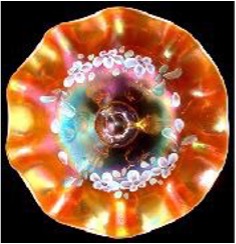
On the illustrated bowl, wild white violets of the type found in woods and prairies, are seen superimposed over a vivid Sunkist orange background.
Forget-Me-Nots are also found on the face of Paneled Cherries bowls. Kate LaValle, the Inter- national Carnival Glass Association’s unofficial horticulturalist, has ID’d the flora on differently decorated hand-painted bowls and provided this photo.
Paneled Cherries is named for its back pattern. Seen on each of three panels is a cherry cluster with three life-size cherries and proportionately large leaves. Each panel is demarcated by an elongated frond. These look like a variety of fern. The three rounded ball- footed legs extend from a pronounced distension dead center on the underside. The outer edge is smooth, not serrated. It is usually, perhaps always, uniridized.
Paneled Cherries bowls are available in several colors: marigold, peach opal, amethyst/purple, oxblood, cobalt, ice blue, and marigold on vaseline. Don Ruppel bought a vaseline with marigold overlay in July 1997 at an estate sale in Corunna, Michigan. He sold it later the same year at the Great Lakes/Burns convention auction. Carl O Burns also reported (Dugan & Diamond Carnival Glass, p. 47) having seen one. The marigold and peach opal are abundant in amounts, the amethyst shades also available in large numbers. The oxblood are scarce. The cobalt and ice blue are rare.
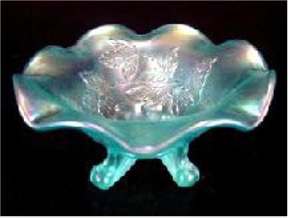
The ice blue, an eight-ruffled from Dick and Sherry Betker’s collection, is an only known. It is significant not only because of its rarity but also because it makes clear that the pattern was produced during the Diamond era as well as by Dugan. The pastel blues (celeste and sapphire as well as ice blue) were introduced in 1916 or 1917 and may also have been made in the early 1920s.
The pattern is seen in several shapes and edge treatments, although not all shapes and edgings are available in every color. These include round with six and eight ruffles, flat- (or square-) ruffled, three-and-one, banana-shape, tri-cornered, and heart- shape. The flat-ruffled is sometimes seen with its sides virtually perpendicular to the surface on which the feet rest, creating what has been described as a nut bowl.
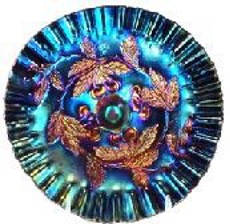
Some shapes are found with the outer edge tightly-crimped, like the Betkers’ spectacularly iridized amethyst/purple pictured here.
A plate in purple is reported as having sold. It may be a relatively flat bowl rather than a plate. but that conclusion is speculative.
Cherries/Daisy and Plume
The interior of Cherries/Daisy and Plume is the most realistic and intricate of the Dugan and Diamond cherries patterns. Like Cherries/Jeweled Heart and Paneled Cherries, three cherries are found in two of the four clusters, two cherries in the other clusters. A distinguishing feature of Cherries/Daisy and Plume is a “sandy” (neither stretchy nor stippled) surface texture extending from the outer rim to about an inch and three-fourths inward. A small open area, about the size of a quarter coin, is found in the deeply recessed center of the bowl.
The Daisy and Plume exterior is so stretched from the shaping that the pattern is distorted nearly beyond recognition. Three stylized blossoms, situated between the legs, and three fluffy plumes, placed directly above the top of the legs, along with a stippled background, make up the design.
The three quadrilateral splayed legs—sides and bottom convex in form, top concave—emanate and extend awkwardly outward from a deeply protruding center. The legs are, more often than not, chipped. This damage probably occurred during production, when the bowl was removed from the mold. The chips are normally unobtrusive because the entire outer surface, including legs, is non-iridized.
The few bowls that have been reported are large, measuring about nine and one-half inches in top diameter. All known bowls have a three-and-one edge.
The first of the two pictured examples had been in Marie Capps’s celebrated collection until it sold on a Seeck online-only auction in June 2016. It is among the prettiest of the tiny number that have surfaced. Its most colorful iridescence, covering the patterned area, is primarily blue, green, and gold. The sandy- textured border is a greenish gold. It’s unfortunate that the provenance of this bowl cannot be traced further back.
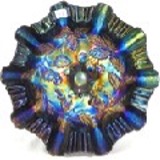
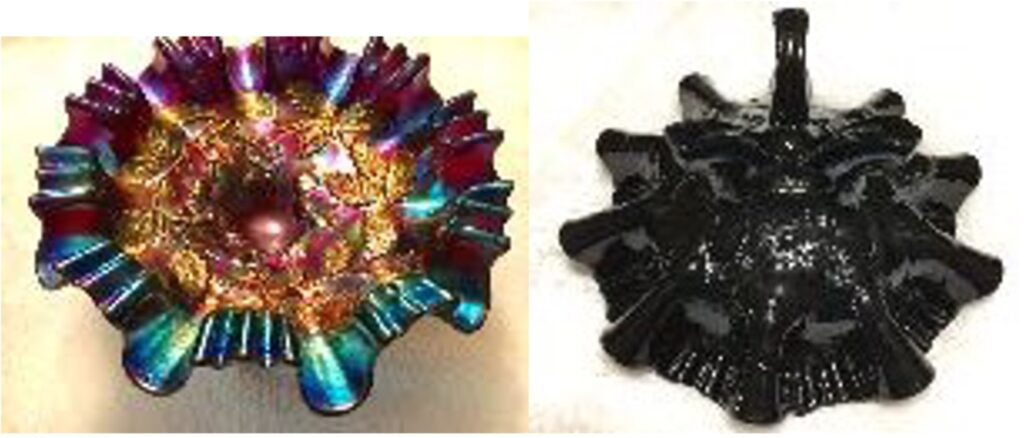
The other impressive example illustrated here is a fiery amethyst from Jay Andreoni’s collection. Its lustrous fuchsia and bright gold iridescence cover the patterned area. Surrounding that is an electric blue border.
Jay said he took a chance when he saw it at a Good Will store in New Berlin, Wis. He didn’t recognize the pattern, and it was so dirty he didn’t know how it would clean up. Detergent and elbow grease quickly resolved the color issue. An internet search in time led him to the original Carnival Pump article on Dugan and Diamond cherries patterns. His investment, he discovered, was well worth the purchase price.
The only colors reported are a translucent fiery amethyst (a reddish purple), like the pictured bowls, and a nearly opaque oxblood. However, peach opal may also exist, as an Absentee Cherries/Daisy and Plume, also three-and-one, sold in August 2016, on a Seeck online auction. Illustrated here, it had been in Jerry and Carol Curtis’s collection until it sold most recently. Its surface color is weak and washed out, the iridescence negligible, and the opalescence confined to the very outer edge. Despite these detracting factors, it is a significant find because it indicates the pattern was made in a color primarily associated with Dugan.

The peach opal Absentee Cherries/Daisy and Plume is an “only-known,” although there must be others. It measures about nine inches in top diameter. Curiously, it weighs noticeably less than the bowl with the Cherries interior.
Sidebar. Oblong Daisy and Plume bowls in peach opal with plain interior sell occasionally. They should be described as Daisy and Plume rather than Absentee Cherries, for they appear to have been a Dugan line item and have never been reported with a cherries interior.
Make no mistake. Acquiring a Cherries/Daisy and Plume bowl is a challenge. They are seen and sell much less often than many of the more highly sought after and much more costly Dugan items.
Wreathed Cherry
Of all the Dugan and Diamond cherries patterns, Wreathed Cherry was produced in the greatest number of shapes. Yet the pattern hardly ever gets much attention, probably because pieces with outstanding color are few and far between.
Interconnected clusters of cherries and veined and stippled leaves (the wreath), along with a single cluster of fruit and leaves directly above and within the confines of the ovular collar base, constitute the interior design. Sometimes referred to as a banana boat, the ovoid master is a foot or more long and nine or so inches wide. The wreath, which covers most of the surface, is made up of eight nearly life-size clusters of fruit, three cherries per cluster, and the connecting leaves. The exterior is made up of four even larger cherry clusters and leaves, each separated by something resembling a stalk of some kind. The collar base, like the bowl, is egg-shaped. It measures three and one-half by five inches. The outer edge is gently eight-ruffled and serrated. It stands four and one-half inches tall.
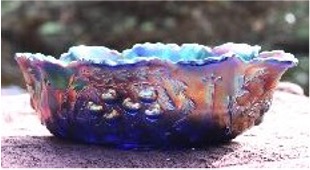
Illustrated is a cobalt blue master bowl. It is the hardest color to find in the Wreathed Cherries pattern.
The wreathed interior of the ovular serving-size bowl has four cherry clusters and the connecting veined and stippled leaves. Each cluster, wreath and center alike, has three diminutive cherries. The outer surface has four cherry clusters separated by stalks. Egg-shaped, slightly six-ruffled, and sawtooth-edged, the small bowl measures four and one-half by six inches, the collar base two by three and one-half inches. They stand two and one-half inches tall.
Master and serving-size bowls are available in marigold, peach opal, amethyst, oxblood, cobalt blue, and white. Marigold, amethyst, and white are found more frequently than the peach opal, oxblood, and cobalt, the latter seen least often. Of the five patterns discussed, only this one is regularly iridized on the underside. The surface colors and iridescence are more often than not marginal in quality, suggesting that production extended well into the Diamond years.
The white often come decorated with painted red or occasionally purple cherries or gold-gilded cherries and leaves. The best of the enameled examples are especially attractive.
All colors are available in berry sets (master and multiple serving-size bowls). Sets were packed at the plant or have subsequently been cobbled together.
Bowls are also found with detachable metal handle or set in a metal frame, making up what are called brides’ baskets and condiment containers, term dependent on the size of the bowl. Large bowls with unpretentious attached handle or set in fancy frame are baskets. They are available in marigold, purple, and white. Handles and frames for these baskets are identical or similar to those found on some marigold, purple/amethyst and cobalt Peach and Pear banana bowls, also ovular in shape. The small bowl in marigold is occasionally seen set in an elaborate frame with insert for a serving spoon. It must have been designed as a jelly or relish dish or a container for another condiment.
A ”bride’s basket” in peach opal is illustrated. It sold on a Burns auction in late May 2014.
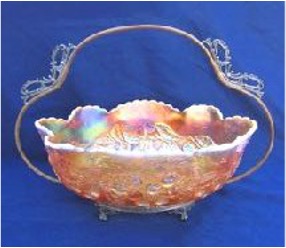
Other Dugan bowls set in metal frames—like large collar-base Ski Star and Caroline, mid-size Daisy Dear, and small deeply ruffled Fishscale and Beads, ruffled and tightly-crimped banana-shape Petal and Fan/ Jeweled Heart, and tightly- crimped banana-shape Smooth Rays/J.H.—also surface from time to time. Frames for baskets and condiment containers were outsourced by the firm, not in- house produced. Two-piece units like these were marketed in small numbers, probably as novelty or niche items, from roughly late 1910 through 1911.
While the Wreathed Cherry pattern was made in water and table sets, and whimsies made from a sugar base and a spooner, in addition to berry sets, only the bowls (master and serving-size) are discussed here.
Weeping Cherries/Western Daisy
Weeping Cherries is anything but an eye-popping pattern. It is interesting in a sense, but with an attendant “ugh factor,” at least to some. it comes across as hastily and crudely designed to the author, but simply a departure from the norm to a pre-publication reader.**
The main elements of the interior are four clusters of fruit and foliage, each with three cherries, and two veined (but not stippled) leaves. The clusters are separated by, as Dave Doty has noted, “baseball bat- like shapes.”
These elements, covering roughly three- fourth of the surface, are set against a grainy stippled background. Encompassing the aforementioned elements is a half-inch band of concave ribs. Dead center, in the recess above the pedestal of the domed base, is a one and three-fourth inch intricate floral medallion with button center. The top diameter of these bowls measures from eight and one-half to nine inches. They have a smooth, non- serrated outer edge.
The Western Daisy underbelly is tough to see. That’s because the pattern is minimally embossed and the surface is radium and non-iridized.***
Fortunately for collectors, Marion Hartung has provided a line drawing of the Western Daisy pattern (Book 4, p. 64). It shows that the design is composed of nine small open blossoms, grouped in threes, each with 12 petals and a prominent stamen, plus several veined and stippled leaves. The base of the domed foot is three and one- half inches in diameter.
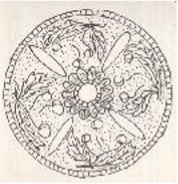
Until recently, Weeping Cherries had been reported in but two shapes and edge treatments: a ten broadly- ruffled and a three-and-one. Three colors are known. Marigold is by far the most frequently seen. A light, wispy amethyst (or lavender) with marigold overlay is also available.
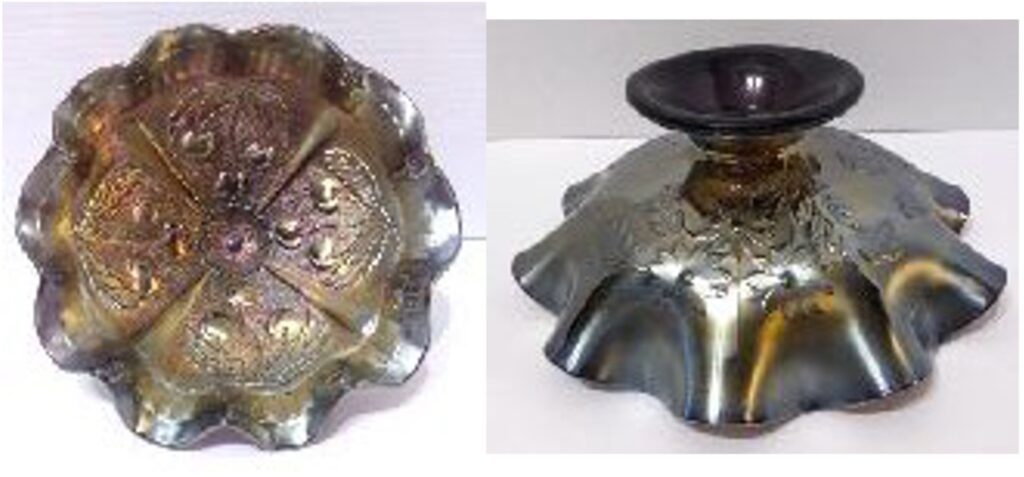
Illustrated is Ingrid Spurrier’s pretty amethyst, without overlay.
In early autumn 2020, Burns Auction Service listed a marigold Weeping Cherries ICS bowl (or perhaps compote or footed plate) for an upcoming auction. Unruffled, its top diameter is eight and five- eighth inches, its height two and one-half inches. Billy Richards bought it on an online auction out of Pennsylvania and consigned it with Tom and Deb. It’s the only Weeping Cherries in this shape Tom has seen.
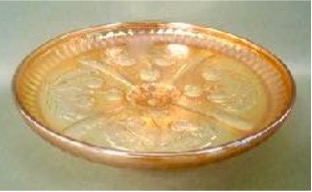
Carl O. Burns suggests (Dugan & Diamond Carnival Glass, p. 149) that Weeping Cherries was designed and put into production some years after Thomas and Alfred Dugan left western Pennsylvania in early 1913. Carl also indicates that bowls in the pattern are available in cobalt blue, but items in that color have yet to be confirmed.
It is possible the Cherry designs and shapes that were made in great quantity by Dugan, Diamond, or both firms may be available in pattern variations. I would be interested in knowing what, if any, variants were produced.
Notes
*After unfolding the last of the bubble wrap on a hot and humid late July afternoon, my thumb stuck to the outer edge of the bowl as I grabbed it. At first, I thought this was a spot where a label had once been affixed. However, on close inspection, I discovered that a sticky film was attached to a wide area where the surface is satiny but not to the radium inner area. It didn’t come off easily. Warm water, a dish cloth, and Dawn detergent got some of it but not all. At that point, I resorted to a courser rag and Soft Scrub which in time got the job done. Initially I wondered why just the broad outer edge but not the inner surface was gummy. Now, in retrospect, I suspect that the bowl had for a time resided with heavy smokers and that cleaning would easily take the grimy residue from the smooth area but cling to the flat finish and stippled surface.
To my pleasant surprise, a bowl that looked nice enough in the listing photo came to greater life with a good cleaning. What was clearly a pretty blue iridescence around the outer portion of the interior became an enticing electric. As the buyer, it was to my benefit its quality was underrated. I wonder if I would have noticed just how dirty it was if it had not been for the oppressive heat and especially the high dewpoint level on the day it arrived.
**Ingrid Spurrier took issue with my draft assessment of the quality of the pattern. My revision, after reading her thoughts, reflects both her and my opinions.
***This design is also the secondary pattern on Soutache bowls and plates. It is the primary pattern on bowls called Western Daisy. These have unpatterned interiors.
This article first appeared in the ICGA Pump in the December 2020 issue and is reprinted with permission.

